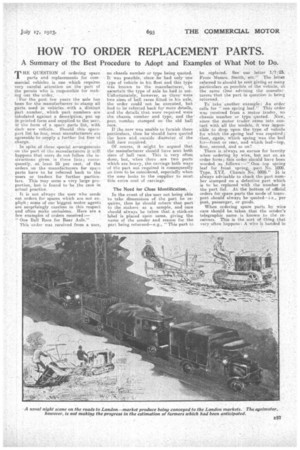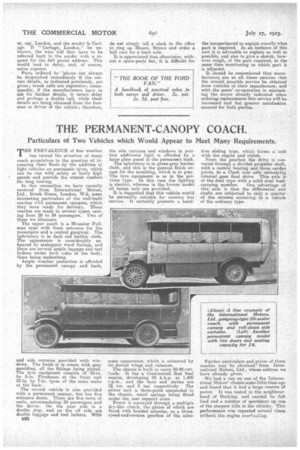HOW TO ORDER REPLACEMENT PARTS.
Page 11

Page 12

If you've noticed an error in this article please click here to report it so we can fix it.
A Summary of the Best Procedure to Adopt and Examples of What Not to Do.
TH-F'QUESTION of ordering spare . parts and replacements for commercial vehicles is one which requires very careful attention on the. -part of the persOn who is responsible for mak ing :out the -order. • ' • For' the -past few years the wile has been for the manufacturers to:stamp all parts, used in _vehicles with a distinct pait number, which part numbers are tabulated against a description, put up in--printed form and supplied-to the user, the form of b: spare parts list, with eachnew vehicle. Should .-this. sparepart list be lost, Most manufacturers' are agreeable to supply A further list free of charge.
In spite of these special arrangements onthe -part of•th:e. manufactUrers it -still happens that users do not follow the inatructions given, in these lists; consequently, .at, least 25 per cent. of the orders on the marnifacturers for spare parts have to be referred back to the Users or fradera for further particulars. This may seem a very largeproportion,. but is found to be the case in actual practice.
It is not always the user who sencl.s out order's for spares which are not expliyit ; some of our biggest motor agents are surprisingly careless in this respect and often make omissions. Here are a. few examples of Orders received:— " One Ball Race for Rear Axle."
This order was received from a user,
no chassis number or type being quoted. It' was possible, since lehad only wee type of vehicle in his fleet and this tyPe was known to the manufacturer, to ascertain the type of axle he had in use. Urifeertimately, however, as there. were two sizes of ball races fitted in his axle, the order could not be executed, but had to be referred back for more detailS, and the details: that were required were the chassis number and type, and the ' part number stamped on the old ball race.
If the user was unable to furnish these particulars, then he :should have quoted the bore and outside diaMeter of the ball race required. Of course, it -might be argued that the manufacturer should have sent both size* of ball race. This is very often -done, but, when there are two parts Which are heavy, the carriage both ways of the part not required is consequently an item to be considered, especially when the user looks to the supplier to Meet this extra cost of carriage.
The Need for Close Identification.
. In the event of the user not being able tee take .dimensions of the parthe requires, then he should returnthat part to the makers aa asample, and care should always be taken that. a stick-on label is placed upon same, giving the name of the sender and reason for the part being returned—e.g., " This part to
be replaoed. See our letter 1/7/23. From :Messrs. Smith, etc." The lettex referred to should be sent giving as many particulars as possible of the vehicle, at the same rime advising the inanufacturers.fhat the part in question is being returned.
To take another example; An order calls for one spring leaf." This order was received from a motor trader.„ no chassis number 'or type quoted. :Now, since the motor trader' came into contact with all the models, it waa impossible to drop upon the type of vehicle for which the spring leaf was required ; -then, gain, which spring was the leaf for—front or rear, and Which leaf—top, first, second, and so on!
There is .always an excuse for brevity when ordering by wire, but not on, an order form; this order should haye been worded .as follows:—' One top spring leaf, for front -spring, part No. 1000. Type, ItYZ. Chassis No.. 5000." It is always advisable to check the part num, her stamped on a defective part which is to be replaced with the number in the part list. At. the bottom of official orders for s.pare parts the mode of transport should always bequoted—i.e., per post, passenger, or goods.
When ordering spare parts by wire care .should be. taken that the sender's telegraphic name is known to the receivers. This is the sort of-thing that very often happens : A wire is handed in at, say, London, and the sender is Cartage. If "Cartage, London,'' be unknown, the wire will then have to be referred back to the sender with a request for the full postal address. This would lead to delay, and, of course,
extra expense. '
Parts ordered by 'phone Can always he despatched immediately if the correct. details, as indicated previously, are given; trunk calls are ,expensive; consequently, if the manufacturers have to ask for further details, it incurs delay and perhaps a double call, while these details are being obtained from the fore• man or driver of the vehicle; therefore, de net simply tell a clerk in the office to ring up Messrs. Brown and order a ball race for a back axle.
It is appreciated that oftentimes, without a spare-parts list, it is difficult for the inexperienced to explain exactly what part is required. In an instance of this sort it is advisable to explain as well as possible, and also to give a sketch, however rough, of the part required, at the same time mentioning to which part it is adjacent.
It should be remembered that maimfacturer are at all times anxious that the utmost possible service be obtained from vehicles of their manufacture, and with the n.sers' co-operation in minimizing the errors already indicated when ordering replacements this service will be increased and fax', greater satisfaction ensured for both parties.




























